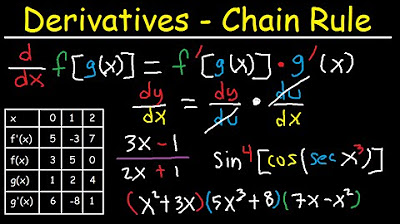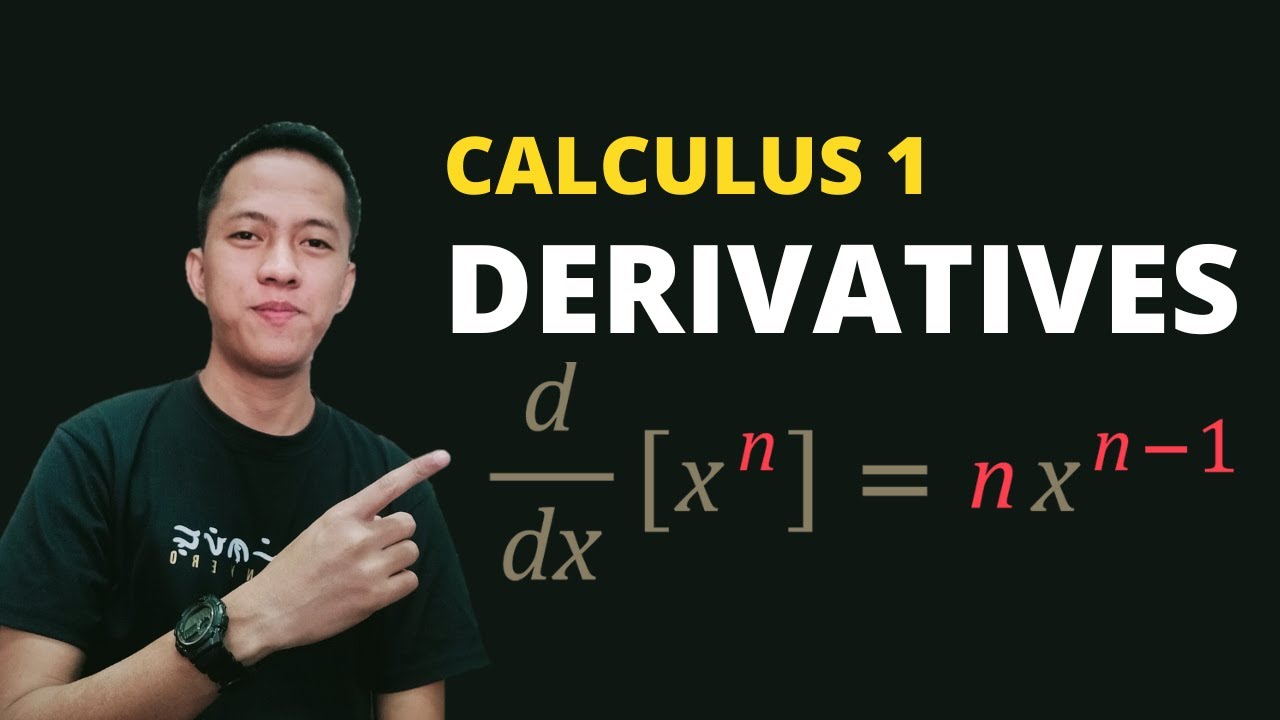Differentiation Rules - Power/Product/Quotient/Chain
TLDRThis tutorial covers essential differentiation rules in calculus, focusing on the power, product, quotient, and chain rules. The power rule simplifies differentiation of polynomials, while the product and quotient rules offer techniques for functions multiplied or divided. The chain rule is essential for nested functions. The video provides clear examples and mnemonics to aid in memorization, ensuring viewers grasp these fundamental calculus concepts.
Takeaways
- 📚 The tutorial covers four fundamental differentiation rules: the power rule, product rule, quotient rule, and chain rule.
- 🔢 The power rule states that the derivative of \( x^n \) is \( n \cdot x^{n-1} \), simplifying the process of differentiating polynomials.
- 📈 For a full polynomial, each term's derivative is calculated separately, and constants result in zero when differentiated.
- 🛑 The product rule is expressed as \( (f \cdot g)' = f' \cdot g + f \cdot g' \), emphasizing the interaction between the derivatives of the two functions.
- 🔄 The mnemonic for the product rule is 'first times the derivative of the second, plus second times the derivative of the first'.
- 📉 The quotient rule is given by \( \left( \frac{f}{g} \right)' = \frac{g \cdot f' - f \cdot g'}{g^2} \), with a helpful mnemonic 'low D high minus high D low, square the bottom'.
- 🔄 The chain rule is applicable for functions within functions, represented as \( (f(g(x)))' = f'(g(x)) \cdot g'(x) \).
- 🔑 The chain rule involves taking the derivative of the outer function and multiplying it by the derivative of the inner function.
- 📚 Mnemonics are provided to help memorize the differentiation rules, such as the product and quotient rules.
- 📉 The tutorial includes examples to illustrate the application of each rule, making the concepts more tangible.
- 🤔 The script encourages viewers to ask questions if they have any, promoting an interactive learning experience.
Q & A
What is the power rule for differentiation?
-The power rule states that the derivative of x to the power of n is n times x to the power of n minus 1, which can be written as \( \frac{d}{dx}(x^n) = nx^{n-1} \).
What is the general form of the product rule in differentiation?
-The product rule states that the derivative of a product of two functions, f(x) and g(x), is the derivative of the first function times the second function plus the first function times the derivative of the second function, which can be expressed as \( (f(x)g(x))' = f'(x)g(x) + f(x)g'(x) \).
Can you provide an example of using the power rule to differentiate x cubed?
-To differentiate x cubed, you bring down the exponent 3 and subtract 1 from it, resulting in 3x squared, or \( 3x^2 \).
How does the quotient rule differ from the product rule?
-The quotient rule is used for differentiating a quotient of two functions, f(x) divided by g(x). It states that the derivative is g(x) times the derivative of f(x) minus f(x) times the derivative of g(x), all divided by g(x) squared, which can be written as \( \left(\frac{f(x)}{g(x)}\right)' = \frac{g(x)f'(x) - f(x)g'(x)}{[g(x)]^2} \).
What is a mnemonic for remembering the quotient rule?
-A mnemonic for the quotient rule is 'low D high minus high D low, square the bottom and away you go', where 'low' represents the denominator and 'high' represents the numerator.
How do you differentiate a function that involves a square root using the power rule?
-A square root can be rewritten as x to the power of 1/2. Using the power rule, you bring down the exponent 1/2 and then multiply by x to the power of -1/2, which simplifies to 1 over 2 times the square root of x, or \( \frac{1}{2\sqrt{x}} \).
What is the chain rule and how is it applied?
-The chain rule is used when differentiating a composite function, where you have a function inside another function. It states that the derivative is the derivative of the outer function evaluated at the inner function, multiplied by the derivative of the inner function, which can be expressed as \( (f(g(x)))' = f'(g(x)) \cdot g'(x) \).
Can you give an example of using the chain rule to differentiate a function raised to a power?
-For a function like \( (x^2 + 3)^5 \), you first differentiate the outer function, bringing down the power 5, and then multiply by the derivative of the inner function, which is 2x, resulting in \( 10x(x^2 + 3)^4 \).
What is the purpose of the mnemonic 'first times derivative of the second plus second times derivative of the first' in the context of the product rule?
-This mnemonic helps to remember the order in which to apply the derivatives of the two functions in the product rule, ensuring that you multiply the derivative of the first function by the second function and vice versa.
How can the product rule be simplified if the derivative of one of the functions is zero?
-If the derivative of one of the functions is zero, such as a constant, then that term in the product rule equation will be zero, simplifying the differentiation process to just the other function's derivative times the original function.
What is the significance of the chain rule in differentiating functions involving trigonometric or other complex functions?
-The chain rule is crucial when dealing with complex functions, such as trigonometric functions, as it allows you to differentiate the outer function while keeping the inner function intact, ensuring the correct application of the derivative of the composite function.
Outlines
📚 Introduction to Differentiation Rules
This paragraph introduces the topic of differentiation rules, focusing on four fundamental rules essential for calculus: the power rule, product rule, quotient rule, and chain rule. The power rule is explained first, demonstrating how to differentiate expressions like x^n by bringing down the exponent and subtracting one. Examples include differentiating x^3 and a polynomial, as well as rewriting and differentiating root x. The paragraph sets the stage for further exploration of these rules with practical examples.
🔍 Detailed Explanation of Product and Quotient Rules
The second paragraph delves deeper into the product and quotient rules. The product rule is explained with the mnemonic 'first times derivative of the second plus second times derivative of the first,' and an example is given to illustrate differentiating x^2 * 3x. The quotient rule is introduced with a rhyming scheme to help remember the formula, 'low D high minus high D low, square the bottom and away we go.' An example is provided to differentiate (x^2 + 2) / (3x + 1), showing the process of applying the quotient rule and simplifying the expression. The paragraph also mentions an alternative approach to the quotient rule using the product rule by raising the denominator to the negative one.
Mindmap
Keywords
💡Differentiation
💡Power Rule
💡Product Rule
💡Quotient Rule
💡Chain Rule
💡Derivative
💡Polynomial
💡Exponent
💡Mnemonic
💡Composite Function
💡Trigonometric Functions
Highlights
Introduction to differentiation rules with a focus on four important rules: power, product, quotient, and chain rules.
Explanation of the power rule for differentiating functions like x^n, resulting in n * x^(n-1).
Example of differentiating x^3 to demonstrate the power rule application.
Differentiation of a polynomial function using the power rule for each term.
Clarification on handling constant terms in polynomial differentiation, which result in zero.
Differentiating root x by rewriting it as x^(1/2) and applying the power rule.
Introduction to the product rule with its general form and mnemonic for easier memorization.
Example of using the product rule to differentiate x^2 * 3x, showcasing the step-by-step process.
Differentiating a polynomial multiplied by a constant using the product rule.
Introduction to the quotient rule with its general form and a rhyming mnemonic for memorization.
Example of applying the quotient rule to differentiate (x^2 + 2) / (3x + 1).
Alternative method for the quotient rule using the product rule by rewriting the denominator.
Introduction to the chain rule with its general form and application for nested functions.
Example of using the chain rule to differentiate (x^2 + 3)^5, illustrating the step-by-step process.
Explanation of the chain rule's application in more complex scenarios, such as with trigonometric functions.
Overview of all differentiation rules with their general forms and mnemonics for memorization.
Conclusion of the tutorial with an invitation for questions and acknowledgment of the viewers.
Transcripts
Browse More Related Video

Derivatives of Composite Functions - Chain Rule, Product & Quotient Rule

Derivatives for Beginners - Basic Introduction

AP Calculus AB and BC Unit 3 Review [Differentiation: Composite, Implicit, and Inverse Functions]

CALCULUS 1: DERIVATIVES

How to take Derivatives in Calculus - Differentiation Formulas - [1-3]

1.7 - The Chain Rule
5.0 / 5 (0 votes)
Thanks for rating: